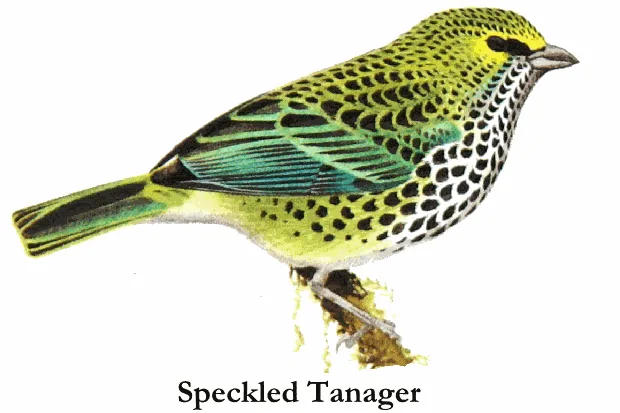
Speckled Tanager
[order] PASSERIFORMES | [family] Thraupidae | [latin] Tangara guttata | [UK] Speckled Tanager | [FR] Tangara macule | [DE] Fleckentangare | [ES] Tangara Pintada | [NL] Spikkeltangare
Subspecies
| Genus | Species | subspecies | Breeding Range | Breeding Range 2 | Non Breeding Range |
| Tangara | guttata | MA | Costa Rica to n, nw Brazil | ||
| Tangara | guttata | bogotensis | |||
| Tangara | guttata | chrysophrys | |||
| Tangara | guttata | eustica | |||
| Tangara | guttata | guttata | |||
| Tangara | guttata | tolimae | |||
| Tangara | guttata | trinitatis |
Physical charateristics
Adult Speckled Tanagers are 13 cm long. The upperparts are green with black spotting, and the face is yellow with a black line from the eye to the gape. The wings and tail are black edged with green, and the underparts are white spotted with black. The sexes are similar.
Listen to the sound of Speckled Tanager
[audio:http://www.aviflevoland.nl/sounddb/S/Speckled Tanager.mp3]
Copyright remark: Most sounds derived from xeno-canto
| wingspan min.: | 0 | cm | wingspan max.: | 0 | cm |
| size min.: | 13 | cm | size max.: | 14 | cm |
| incubation min.: | 13 | days | incubation max.: | 14 | days |
| fledging min.: | 14 | days | fledging max.: | 14 | days |
| broods: | 1 | eggs min.: | 2 | ||
| eggs max.: | 3 |
Range
Middle America : Costa Rica to North, Northwest Brazil
Habitat
A subtropical species occuring in humid montane and secondary forest, with low trees and a dense understory. found in tree canopy and shrubs usually in more open wooded sites such as forest edges, clearings, shady gardens.
Reproduction
The small cup nest is built of fiber 3-8 meter up mostly located at the edge of the forest. Clutch size is two brown-blotched white eggs. The female incubates the eggs for 13 days to hatching, with another 15 days before the fledgeing
Feeding habits
Speckled Tanagers are social birds which eat mainly fruit and some insects.
Conservation
This species has a very large range, and hence does not approach the thresholds for Vulnerable under the range size criterion (Extent of Occurrence <20,000 km2 combined with a declining or fluctuating range size, habitat extent/quality, or population size and a small number of locations or severe fragmentation). The population trend appears to be stable, and hence the species does not approach the thresholds for Vulnerable under the population trend criterion (>30% decline over ten years or three generations). The population size has not been quantified, but it is not believed to approach the thresholds for Vulnerable under the population size criterion (<10,000 mature individuals with a continuing decline estimated to be >10% in ten years or three generations, or with a specified population structure). For these reasons the species is evaluated as Least Concern.

Migration
Sedentary throughout range
Distribution map

]]>
